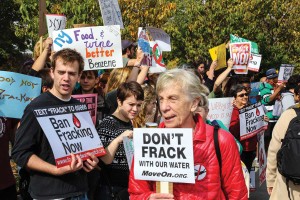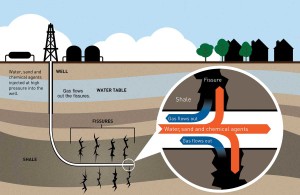Fracking Facts
06 Apr 2015
Fracking is a divisive issue, and properly regulating it is difficult until conclusive data are available.
By Tanya Ishikawa At least two truths about fracking are indisputable: It’s controversial and the risks to human health and the environment are not clearly known. The fracking process is becoming better understood, but experts agree that more data and analysis of the impacts are necessary before we can make informed decisions on how much fracking to allow, where to allow it, and for how long. Fracking, short for hydraulic fracturing, is part of a natural-gas extraction method (see “What Is Fracking?” below). It’s opposed by environmentalists and concerned commmunities due to the impacts on land, water and air, but gas companies and others who see the economic benefits stand fast in advocating their right to profit from fracking. While the courts, city governments, state agencies, lobbyists and citizens’ groups take turns banning or preventing bans on the controversial process, the public remains unclear as to whether the pros outweigh the cons or vice versa. “The two fundamental questions are, is this a choice between economic development and environmental protection, and what role does natural gas play as an environmentally pragmatic energy source until we can harness clean-energy sources on a large scale?” says Jonathan Koehn, regional sustainability coordinator for the city of Boulder. Koehn oversees the city’s natural-gas working group, volunteers who study and make recommendations about what role gas is going to play in Boulder’s energy portfolio as the city transitions to operating its own electric utility. “We’ve often thought natural gas is a good transitional energy source, less polluting than burning coal, but when we consider the full environmental impact it begins to look less positive,” Koehn says. “Understanding the whole spectrum of benefits and risks is critical.” His group is considering the development of a certification process for potential gas suppliers, which may affect how procured gas is obtained. It’s also examining extraction and transportation practices that the city might require in the future. Meanwhile, Boulder County Commissioners voted in November 2014 to extend a moratorium on processing new drilling permits to July 1, 2018. The purpose of the extension, says Patrick Murphy, the county’s public health oil and gas specialist, is to wait for useful results from current studies of fracking’s impacts. “Unfortunately, the impacts to human health are still unclear. It’s imperative that more research be done in this area to ensure our communities are safe from harm, including understanding the risks to oil and gas workers and adults and children living near oil and gas sites, as well as those who do not live near development,” Murphy says. “Public safety must be our priority. We recommend a thorough human-health risk assessment that uses an EPA-approved methodology. Unfortunately, there is currently no funding available for such a study.”
Public Portal
As the fracking controversy has grown, many short-term government and industry studies have been released, but results have been called into question by one side or another. Since October 2012, a consortium led by a team from the University of Colorado Boulder has explored ways to maximize the benefits of natural-gas development while minimizing negative impacts on communities. Funded by a $12 million National Science Foundation grant, research partners include the Colorado School of Mines, Colorado State University, the University Corporation for Atmospheric Research, the National Renewable Energy Laboratory, the National Oceanic and Atmospheric Administration, the University of Michigan, and California State Polytechnic University Pomona. The project, scheduled for completion in 2017, is expected to reveal not only reliable evidence of fracking’s impacts, but also a decision-making process for determining to what extent this type of gas extraction should be limited or banned (see “Weighing the Impacts” below). The consortium, which consists of more than 65 collaborators, is reviewing past research, conducting new studies and pulling together various community groups to gather data and share information. Though the team is still doing analyses and correlations, project leader professor Joseph Ryan of CU’s Civil, Environmental and Architectural Engineering department expects some useful information to be released on the project’s website this summer. “We should be creating that public portal to increase awareness and understanding—it’s on our to-do list,” he says. “Our project is probably the single biggest effort to study fracking. We’ve been spending a lot of time getting work done,” he says, but getting results to the public hasn’t been a high priority at this point. “Even if some ogranization puts out balanced information, the public still has a tendency to distrust it,” Ryan says, citing the Environmental Defense Fund’s efforts to gather fracking information as the “best example I’ve seen” of an environmental group’s efforts to “present a balanced view.”More Q’s than A’s
While data gathering continues, Colorado’s Oil and Gas Task Force is coming up with recommendations for how state and local governments should regulate oil and gas development, including fracking. Established by an executive order from Gov. John Hickenlooper last September, the task force includes representatives from local government, civic organizations, environmental interests, and agriculture and gas-related industries, who must develop rules that balance land-use issues, minimize conflicts, protect communities and allow reasonable access to private mineral rights. The question of landowners’ versus mineral owners’ rights on the same property is a confusing and controversial component of fracking. The fact remains that historic property laws give mineral owners the right to extract those resources, so decisions must be made on what impacts are acceptable for the landowner and nearby neighbors while keeping the process economical for the mineral owner. “If you have a neighbor who is doing something on his or her property that could damage you, you should be able to keep them from doing that. I think it’s the same case here,” Ryan says. “If someone owns the mineral rights under my surface, and if they can get to it safely, they should be able to do that. In our legal system you have to prove damages first before you can get any legal recourse, and that puts the public in a difficult position.” He admits many questions his study won’t be able to answer will continue, such as possible water contamination at great depths that could take decades to appear at the surface, and the effects of long-term exposure to carcinogens used in fracking. Based on some preliminary findings, however, Ryan predicts the studies will show infrequent occurrences of groundwater contamination from oil and gas development. He realizes those results don’t make it any less of a problem for those few people who may be affected by contamination. Still, he explains, “We hope that some of our message will help people to have some appreciation of what that probability is, what the risk is, to them.” In terms of human health and larger-scale climate effects, nearly all mercury contamination in the atmosphere and Colorado’s reservoirs comes from burning coal. In that respect, natural gas has environmental benefits since it doesn’t release mercury into the environment, Ryan notes. However, global risks are increased unless the methane in the shale layers can be captured or prevented from escaping during extraction. Methane is a much stronger greenhouse gas that leads to greater climate change than burning coal. “To me, the big challenge is how can we be good environmentalists who still use some fossil fuels?” Ryan says. “How can we determine which global benefits outweigh the risks of the local, regional and global impacts of fracking?” Unfortunately, those questions are as yet unanswerable.
What Is Fracking?
Today more than 90 percent of all new U.S. onshore oil and gas development involves some form of hydraulic fracturing. The process extracts natural gas and oil from thin shale layers deep underground, and happens in the following steps:- A well is drilled thousands of feet down to a shale layer where natural gas is trapped.
- A drill bit moves horizontally across the shale layer to create a shaft.
- Small explosive charges are detonated along this shaft to open fissures, or fractures, in the shale.
- Though it takes all the above steps to allow hydraulic fracturing to happen, the specific process that the term refers to is when fluid—consisting of 99.5 percent water and sand and 0.5 percent chemicals—is injected at high pressure into the fissures. The water’s purpose is to transport the sand; the sand’s purpose is to keep the fissures open to allow the natural gas and oil to flow back to the well bore. The chemicals, similar to those found in household cleaners and cosmetics, are added to improve production—predominantly for lubrication, to keep bacteria from forming, and to help transport the sand.
- The natural gas, oil and fluid mixture flows to the surface, where the oil and natural gas are extracted and the fluid is saved for reuse or recycling (another controversial issue).












